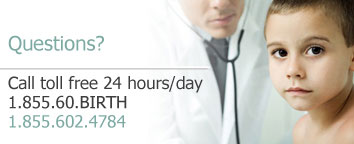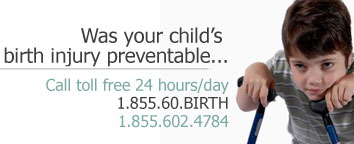Umbilical Cord Problems and Birth Injuries
 In many cases, a birth injury is the result of umbilical cord problems. Statistics from the Pregnancy Institute reveal that umbilical cord problems cause stillbirth in 1.5 of over 1,000 births. In some cases, a birth injury is an unfortunate accident, but in other cases, it was preventable, and was the result of mistakes made by the healthcare professionals overseeing the birth.
In many cases, a birth injury is the result of umbilical cord problems. Statistics from the Pregnancy Institute reveal that umbilical cord problems cause stillbirth in 1.5 of over 1,000 births. In some cases, a birth injury is an unfortunate accident, but in other cases, it was preventable, and was the result of mistakes made by the healthcare professionals overseeing the birth.
Umbilical cord prolapse
This type of umbilical cord complication can occur before or during delivery. Umbilical cord prolapse occurs when the cord prolapses (drops) through the dilated cervix and into the vagina, before the unborn baby does. When the baby moves through, the baby’s body can then trap and compress the cord, cutting off oxygen to the baby, which can result in fetal distress, brain damage, other birth injuries, or stillbirth.
This complication can happen due to premature rupture of the membranes containing the amniotic fluid or due to breech presentation. However, in most cases, obstetricians can detect the problem in time and either move the baby away from the umbilical cord, or deliver the baby via C-section.
Nuchal cord and cord knots
Nuchal cord is an umbilical cord wrapped around the baby’s neck. Statistics from the March of Dimes reveal that this occurs in approximately 25 percent of births. The problem can usually be detected with ultrasound, but often no intervention is necessary.
Cord knots occur when the umbilical cord actually gets knotted, which can happen as the fetus moves around in the womb. The risk of cord knots is higher when the cord is extra-long or when the mother is carrying identical twins. As long as the knots remain loose, they are not a danger to the baby, but if they tighten, then the baby’s oxygen supply may be cut off. If this happens, a fetal monitor should detect fetal distress, and the obstetrician should notice this and would most likely order a C-section to prevent birth injuries.
Vasa previa
Vasa previa occurs when blood vessels from the placenta or umbilical cord grow along the membranes near the opening of the cervix. As the baby drops down into the pelvis during delivery, the baby’s body can compress these blood vessels, cutting of the oxygen supply and causing a decrease in the baby’s heartrate. Obstetricians can often detect such a problem before labor starts; if not, fetal monitoring should detect fetal distress and the obstetrician can perform a C-section.
A birth injury attorney can help
Obstetricians and other healthcare professionals are trained to detect the warning signs of a birth emergency and to handle it promptly and appropriately. If your baby suffered birth injuries because of mistakes made by healthcare professionals during labor or delivery, you may be eligible to recover damages through a birth injury lawsuit.
The expert attorneys at Balkin & Eisbrouch have more than four decades of experience in seeking justice and recovering damages for victims of medical malpractice, negligence, and birth injury. Call us today for a free consultation about your case. There is no cost to you unless we win you a settlement.



